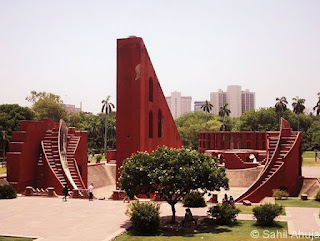For those seeking unique and historical tourist destinations in India, the Jantar Mantar in Delhi stands as a fascinating testament to India's scientific heritage. This intriguing complex of astronomical instruments, built in the 18th century by Maharaja Jai Singh II of Jaipur, offers a captivating glimpse into ancient Indian astronomy. If you're planning your Delhi sightseeing, the Jantar Mantar is a must-see attraction in Delhi for history buffs, science enthusiasts, and anyone curious about India's rich past. Our ultimate guide will help you explore the wonders of this remarkable Indian landmark.
A Step Back in Time: The History of Jantar Mantar
The Jantar Mantar in Delhi is one of five astronomical observatories built by Maharaja Jai Singh II. The others are located in Jaipur, Ujjain, Varanasi, and Mathura. The Delhi observatory was constructed in 1724 and was designed to study celestial movements and calculate time. Its name, Jantar Mantar, literally translates to "instruments for calculating the harmonies of the planets." This historical significance makes it a key popular place in Delhi.
Architectural Precision: The Instruments
The Jantar Mantar's architecture is as impressive as its purpose. The observatory houses several unique and large-scale instruments, each designed for specific astronomical observations:
- Samrat Yantra: The largest instrument, a massive sundial used to calculate time with remarkable accuracy.
- Jai Prakash Yantra: A hollowed-out hemisphere with markings to map celestial bodies.
- Mishra Yantra: A combination of five instruments designed to determine the time of noon in different cities.
- Ram Yantra: A cylindrical structure used to measure the altitude and azimuth of celestial bodies.
Exploring these instruments offers a tangible connection to the advanced astronomical knowledge of 18th-century India, making it a truly unique tourist attraction in Delhi.
Experiencing the Wonder: Your Visit to Jantar Mantar
Visiting the Jantar Mantar is a fascinating experience. While the instruments might seem abstract at first, understanding their purpose and scale offers a sense of awe. Guided tours are often available and highly recommended to fully grasp the significance of each instrument. The site provides a peaceful contrast to the bustling city, allowing for contemplation of India's scientific past. It's an essential addition to any Delhi tourism itinerary.
Planning Your Visit: Timings, Entry Fee, and More
Here's what you need to know to plan your visit to this unique Delhi tourist place:
- Timings: Generally open from 9:00 AM to 6:00 PM daily (check the official website for any changes).
- Entry Fee: There is a nominal entry fee for Indian citizens and foreign nationals.
- Photography: Photography is permitted.
- Location: Located in Connaught Place, the heart of New Delhi, making it easily accessible by metro (Rajiv Chowk station is the nearest).
Nearby Attractions: Exploring Central Delhi
The Jantar Mantar's central location makes it convenient to visit other popular places in Delhi nearby, such as Connaught Place itself, India Gate, and the National Museum.
Top FAQs:
- What is Jantar Mantar in Delhi? It is an 18th-century astronomical observatory built by Maharaja Jai Singh II.
- Where is Jantar Mantar located in Delhi? It is situated in Connaught Place, New Delhi.
- What are the opening hours of Jantar Mantar? Generally 9:00 AM to 6:00 PM daily (verify on the official website).
- Is there an entry fee for Jantar Mantar? Yes, there is a nominal fee for both Indian and foreign visitors.
- What are some of the main instruments at Jantar Mantar? Samrat Yantra (sun dial), Jai Prakash Yantra, Mishra Yantra, and Ram Yantra.
- Why was Jantar Mantar built? To study celestial movements, calculate time, and advance astronomical knowledge.
- Is a guided tour recommended at Jantar Mantar? Yes, a guided tour can greatly enhance your understanding of the instruments and their functions.
Conclusion:
The Jantar Mantar in Delhi offers a unique and enriching experience for travelers interested in history, science, and the wonders of ancient Indian intellect. This remarkable Indian landmark stands as a testament to the advanced astronomical knowledge of its time. As you plan your Delhi sightseeing, make sure to include a visit to the Jantar Mantar to witness firsthand the architectural precision and scientific significance of this fascinating tourist destination. It's a journey back in time and a chance to marvel at the ingenuity of India's past, making it a truly unforgettable stop on your exploration of India.











No comments:
Post a Comment